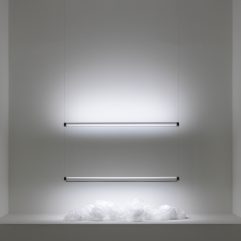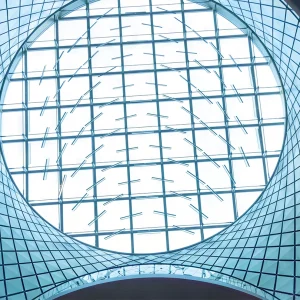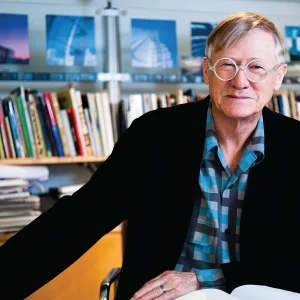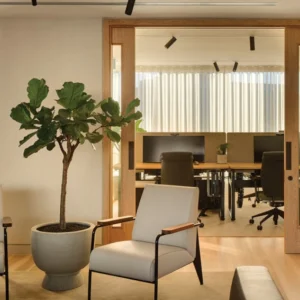
WHILE THE use of colour lighting, especially in the exterior environment, rightfully remains an important subject for debate, there is, of course, nothing intrinsically wrong with a polychromatic scheme. It is worth remembering that all those ancient classical sculptures and medieval church interiors now tastefully and unalarmingly monochromatic would have been vividly colourful in their original state.
 Image Credit: Orn Erlendsson
Image Credit: Orn Erlendsson
As long as it is appropriate (to location, purpose of building or space), uses a carefully considered palette, and serves the purpose of the brief, colour is a powerful tool for urban regeneration, for wayfinding, branding, mood setting and sheer entertainment.
 Image Credit: Orn Erlendsson
Image Credit: Orn Erlendsson
After all, a lighting scheme can be badly done whether it is white or RGB. The difference is that the badly executed coloured scheme is a rather less subtle mistake, and can be a powerful and even offensive intrusion especially in the night-time environment.
 Image Credit: Orn Erlendsson
Image Credit: Orn Erlendsson
The following two schemes, both award-winning, are exemplars of both the power and subtlety that can be achieved with the use of coloured light. And anyone who is a purist about the use of colour in religious buildings should perhaps remember those medieval interiors.
 Image Credit: Orn Erlendsson
Image Credit: Orn Erlendsson
THERE IS nothing more bald than a light fitting with a transparent diffuser and a clearly visible lamp. Even once-trendy and still persistent LED filament lamps look a bit stark, though they are not the glaring errors often created by clear glass and the old incandescent sources.
 Davide Groppi’s Magia tubes can be suspended singly or in twos and threes. Image Credit: Davide Groppi
Davide Groppi’s Magia tubes can be suspended singly or in twos and threes. Image Credit: Davide Groppi
But transparency, as much as gentler translucency, can offer soft and subtle light effects if the light source is controlled and choreographed. Two of the latest luminaires from Davide Groppi – who seems to be on a mission to disappear the light fitting altogether such is his preoccupation with minimalism – play with the illusions that can be effected by using transparent materials for diffusion. Artemide also uses sleight of hand with a soon-to-be-available table lamp with the source in the base. Meanwhile, an award-winning experimental light installation uses hand-blown glass to explore the interplay of artificial and winter light.
HALLGRÍMSKIRKJA, REYKJAVIK, ICELAND
LIGHTING DESIGN Liska
 Image Credit: Ye Song, Hanmo Vision
Image Credit: Ye Song, Hanmo Vision
Located in Iceland’s capital, Hallgrímskirkja is the country’s largest church, and with its 73m-high tower one of its most photographed landmarks. Commissioned in 1937, begun in 1945 and finished in 1986, it was designed by architect Guðjón Samúelsson to honour 17th-century saint and poet Hallgrímur Pétursson. Samúelsson was fascinated by volcanic activity and the shapes formed from cooled lava. Inside, the lines of the architecture soar into the high vaults, evoking the shape of a geyser.
The project involved renewing the decades-old lighting in the main hall of the church and in the organ room, with the usual issues of heritage and functionality of the church, like many ecclesiastical buildings used for both services and secular events.
The lighting concept, winner of an Award of Merit in the 2023 IALD awards among others, was designed to highlight the architectural features and emphasise the volume of the interior. It was heavily influenced by the Nordic lights sky and its rhythms. ‘The lighting scenes give depth and dimension, optically broadening the church during community events or emphasising verticality for spiritual events,’ says Reykjavik-based designers Liska, the Icelandic word for chromaticity.
Practically that meant a versatile smart lighting system with Erco LED spotlights, sensors, and dynamic wireless control that could work both with the surroundings and a changing calendar of cultural events.
Warm white downlighting creates a comfortable general ambience while RGBW fittings in vaults and corridors highlight architectural features and provide the opportunity for creative colour scenes during special events.
The altar is illuminated by tuneable white spotlights, which stand out regardless of the colour of other lights. Tuneable white frontlighting and RGBW backlighting of the organ creates a shadow play that shifts with temperature and colour.
Different temperatures of white light are used to delineate the exterior architecture. The facade, roof and tower are grazed with colder tones, offsetting the warm lighting of the interior and clock tower. Light fixtures are carefully positioned to be discreet and to enhance the sculptural, three-dimensional surface with its descending columns.
It is rare to have an exterior scheme that picks up where the interior left off (or vice versa), but there is a harmony between the interior and exterior lighting, with communication between the wireless indoor and outdoor DMX light fittings. The Pharos external lighting control system allows for dynamic colour displays and animations. ‘Externally, the facade acts as a display of engagement in religious and national celebrations or international movements,’ says Liska.
Energy saving was a key criterion, with sensors and smart cycles used to reduce energy consumption inside, while outside an automatic lighting cycle adjusts to the Nordic winter darkness, saving energy through the brighter periods by applying dimming profiles. All exterior lights are then turned off during the night to reduce light pollution.
Founded seven years ago by a team of lighting designers and electrical engineers, Liska has been something of a pioneer in lighting design in Iceland. The firm has based its lighting approach on prioritising the specific needs and well-being of individuals, and living organisms, occupying spaces or environments.
‘In Icelandic schools, for example, we’ve been putting the focus on the biological effect light has on kids and members of the staff,’ Katerina Blahutová, architect and lighting designer at Liska told Scan Magazine. ‘Adjusting the colour temperature and intensity at certain times throughout the day can help preserve circadian rhythms, thus affecting the children and helping establish routines beneficial for their development.’
It is a pertinent consideration given the particular conditions of Icelandic light, with dark winters and long summer days, which inevitably affect the mental and emotional well-being of its inhabitants.
‘Our human-centric lighting approach is very much based on circadian rhythms and our design caters to these changes in human energy throughout the day,’ adds Blahutová. ‘On the Hallgrímskirkja project, the colour temperature and intensity of light is adjusted throughout the day to give visitors a sense of natural rhythm.’ liska.is
Client: Hallgrímskirkja Church Committee Architect: Guðjón Samúelsson; Andrés Narfi Andrésson
IINC BOUTIQUE, HANGZHOU, CHINA
LIGHTING DESIGN YAANK Lighting Design
 Image Credit: Ye Song, Hanmo Vision
Image Credit: Ye Song, Hanmo Vision
The influence of venerable and venerated light artist James Turrell runs through lighting, and occasionally culture generally, like a stick of rock (the recent Channel 4 ident is just one example). YAANK’s scheme for the IINC fashion boutique, winner of an IALD Award of Excellence, is a direct tribute.
‘[The scheme] pays homage to the famous artist James Turrell, using the space as a container for light, enhancing the experience through a visual linkage that immerses the customer in an atmosphere of purity and change,’ says Ke Yang, lead designer of YAANK, a Hangzhou-based interdisciplinary team of installation artists, lighting designers and spatial designers.
The starting point of the scheme was whiteness – an intrinsically clean, minimalist space that, in the central area, becomes a canvas for colour change. In the ‘promenade’ display area around the central space the light focuses on the clothing with garments displayed like works of art. There was an element of trial and error, with five different approaches to lighting the merchandise considered before the lighting team settled on fittings hidden within the structure, says Yang. ‘It’s not only concealed but also acting as a decorative feature, a lighting design that satisfies two situations at the same time.’
The neutral 4000K colour temperature was chosen ‘to make the pure white space more pure’, a watchword of the project. ‘The overall lighting approach is based on “purity”, the luminaires being integrated with the structure of the space to maintain its integrity,’ says Yang.
 Image Credit: Ye Song, Hanmo Vision
Image Credit: Ye Song, Hanmo Vision
Daylight was the ideal – ‘bringing in natural light is the best way of expressing the high quality of white minimalism’ – but the constraints of the project location made this impossible. Instead the lighting team created an artificial skylight.
The central space accommodates special functions, such as new product launches, runway shows, or brand VIP events, hence the need for more atmospheric lighting scenes. Its complex, curvilinear geometry features an interspersed combination of lights and horizontal slots. From within, the concealed LEDs and reflective film wash the space uniformly with subtly different and tightly controlled bands of pastel colours, inspired by the hues of sunrise and sunset, and reminiscent of the boundary-blurring effects of Turrell. ‘When light with colour enters the space, it begins to breathe slowly and the colours change to match the theme of the event,’ says Yang. yaankdesign.com/IINC
Architect: Fununit Design
MAGIA
DAVIDE GROPPI
 Image Credit: Davide Groppi
Image Credit: Davide Groppi
Designed by Michele Groppi, Magia is a modular suspension lighting system that can be adapted to suit different ceiling heights. With a 360° adjustable module it can generate direct and indirect light. The convex lens conceals part of the emitted light.
‘In this case, the lens is not used to focus, but to modify the vision and perception of the object,’ says Groppi.
Measuring 1,400mm, the tubes can be suspended singly or in twos and threes and come in warm white (2700K and 3000K, CRI>90). End cap finish is in polished black or polished gold.

The fitting was one of three Groppi products that won in the lighting category of the the Archiproducts Design Awards 2023.
BOLTONS
HERZOG AND DE MEURON FOR ARTEMIDE
Reflecting a 21st-century trend in marrying the technically sophisticated with the artisan executed, Herzog and De Meuron’s Boltons combines patented optical technology with hand-crafted glass. The transparent body – created using a traditional technique that includes an air bubble inside the glass – supports an orientable metal disc, 260mm in diameter, matching the height of the luminaire.
The total transparency highlights the thickness of the material, which is chunkier in the upper part, becoming thinner on the sides where it stretches. The form also optically defines the ability to control and move light on the surface.
A lens at the base directs the entire light emission upwards (from a 7W LED source), controlling it precisely so that the disk can then reflect it according to its inclination. The geometry of the glass allows a wide freedom of movement for the upper reflector, which is fixed with a magnetic sphere.
The glass, crossed by the light beam, is animated by reflections without losing the efficiency of the optical system.
VIS À VIS
DAVIDE GROPPI

Also designed by Michele Groppi, like the Magia on the previous page, and another winner in the Archiproducts Design Awards, Vis à Vis reinterprets Groppi’s first portable lamp, TeTaTeT, ten years on. Just over 200mm high, the transparent stem, with magnetic head, supports a 300mm transparent methacrylate disc. This produces a refractive effect using a Fresnel lens. The 2W LED source also comes in warm white (2700K with an output of 110lm or 3000K 113lm, both CRI>90). The battery life is nine hours.

MOIST SPARKLE
DESIGNER: ARASH ABBASZADEH, UNIVERSITY HOCHSCHULE WISMAR

Winner of a 2023 LIT Lighting Design Award in the Emerging Lighting Product Design of the Year category, Moist Sparkle is a light art installation. The aim was to capture the interplay between morning dew and daylight, especially the particular interaction with the light of the sun on the winter horizon.
The installation in an old barn, open on one side to the elements, features cold colour temperature artificial light, which combines with natural light, the extended ‘blue light’ hours of northern Europe’s winter. The crucible for this interaction is a series of incomplete artisan-blown glass spheres, reminiscent of raindrops and each containing varying salt and water concentrations.
Using a single narrow-beam uplight, the aim was to graze the droplets, revealing the miniscule and intricate frozen bubbles within and the dew on the outside, creating two distinct experiences for the viewer, ‘from both micro and macro perspectives’.
The installation was created by Iranian-born architect Arash Abbaszadeh who is currently working on his second master’s degree in architectural lighting design at Wismar University in Germany. ‘This academic endeavour represents a significant step in my commitment to exploring innovative intersections between light and space,’ he says.
Abbaszadeh was inspired by a metaphor found in German literature, where the incidence of morning dew on a spider’s web is likened to moisture on silver hair.
The aim was not just to create a physical representation of a natural occurrence but, also by setting it in an old barn, to evoke emotional connections with the sound of rain and winds into the cold abandoned edge of the building. ‘By translating the metaphor into a visual and immersive experience, the installation tried to become a poetic dialogue between nature, literature and light.’
 Abbaszadeh says that the light installation ‘required numerous iterations’ to achieve the perfect refraction
Abbaszadeh says that the light installation ‘required numerous iterations’ to achieve the perfect refraction
The process involved trial and error with each droplet contained different concentrations of salt and water, the delicate appearance of light within frozen water achieved through the careful variation of salt concentrations. ‘Achieving the perfect refraction required a delicate balance that necessitated meticulous experiments and adjustments,’ says Abbaszadeh.
His hope, says Abbaszadeh, is to see a general improvement in understanding the the significance of architectural lighting design, and ‘the substantial difference between designing with light and superficially, merely lit, surfaces.’





